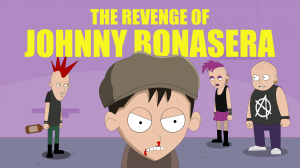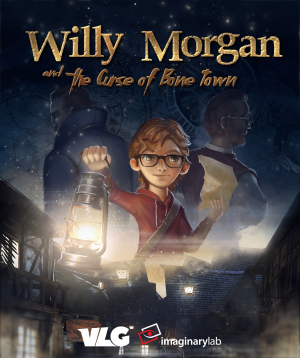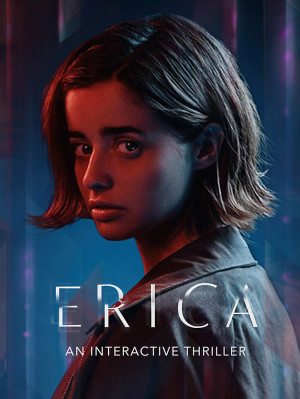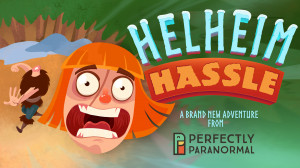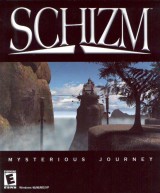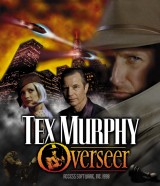Review for The Revenge of Johnny Bonasera
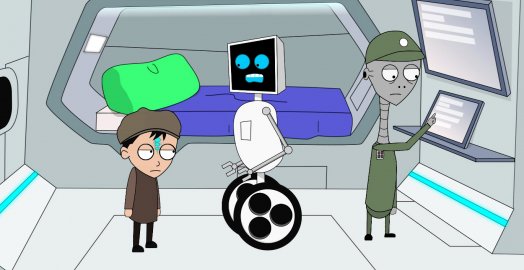
Any adventure gamer who was on the internet in the early 2000s remembers Flash games. Certain websites would host massive troves of simple games created in Adobe Flash, often using MS Paint-style graphics. Early on, point-and-click adventures featuring silly, crude humor dominated these sites. I couldn't help but reminisce on this strange era when I was playing The Revenge of Johnny Bonasera. While not made in Flash, this four-part series by Rafael García captures a lot of the spirit and attitude of that time in gaming, especially in the earlier episodes. And while it never totally shrugs off that indie anarchic feel, as you continue into the later chapters, the game does evolve into something more, and more impressive. Indeed, even as several aspects of this game are underwhelming on their own, the end result overall left me hungry for more from García as a game creator.
But let's start at the beginning.
You begin as the titular protagonist (possibly a cheeky nod to Amerigo Bonasera, a revenge-seeking character in The Godfather), a simple boy whose primary motivation is his love of food. As young Johnny indulges this desire by eating a sandwich on the street, suddenly three punks approach, knock the food out of his hand and rough him up, causing him to limp back to his treehouse. This is where Johnny's quest begins, as he swears revenge on the thugs, armed with only his determination and his trusty baseball bat.
The first chapter is the realization of this straightforward objective. It's about an hour of classic inventory-based point-and-click puzzling as you uncover the weaknesses of each goon and exploit them to exact your vengeance. The puzzles are serviceable and occasionally challenging, but the game itself is rough. The graphics are 2D and cartoonish, reminiscent of Family Guy, with basic backgrounds composed of bright solid colors and clean lines. An inventory can be pulled up with an icon, and clicking on hotspots brings up two available actions, primarily Look At and either Use or Talk. Bizarrely, the former is an image of the Eye of Horus, which is never addressed and feels totally out of place. More distracting is that the English translation is poor, the animation stiff, and the music very noticeably odd. There is a point at which you walk into a dingy back alley and for seemingly no reason at all, a jaunty piano rendition of the Christmas song “Sleigh Ride” begins playing.
These quirks are easy to overlook, however, as the puzzles mostly make intuitive, logical sense, though a few left me stumped, making me really sit back and think about the situation. With the odd exception, like passing off a pen drawing as a photograph, I largely enjoyed the gameplay. The issue I found hard to look past was the nihilistic, puerile humor. You’ll trade cigarettes to a child, soak a cloth in urine and put it in someone's face, and later pluck someone’s entire head of hair out with tweezers. The cruelty is clearly intentional, but it lacks the nuance and self-awareness you'd want from humor that cheap and immoral. And this problem only deepens with episode two.
Each chapter gets more complex, both in storytelling and in game design. The second installment opens with a prologue, as Johnny's favorite superhero, Capitán Wachimolete, floats in space outside the mothership of a race of aliens, on a mission from a secret government organization to destroy them. Capitán Wachitomele is a Mexican-food-themed superhero who eats chili peppers to activate his fire breath and devours beans to activate his powerful flatulence that can knock foes unconscious. At the start of this chapter, you play as the Capitán in a series of burps, farts, pukes, and anal probes that really up the ante on the gross-out humor.
A short time later, you're back in the role of Johnny, trying to escape an interview with members of the same secret organization and outsmart a station full of police in an attempt to find your way to the aliens. Many of the same characters return in surprising and fun ways, and this chapter introduces new styles of gameplay, including time-based situations (such as a match burning out before you can use it) and dialogue-based obstacles (like needing to say the exact right thing to get out of a tricky situation). There are several subplots that work their way into the narrative as well, and all of them work together very nicely.
Unfortunately, the toilet humor really gets in the way. I'll illustrate it this way: there’s a puzzle sequence that involves making a man defecate and using the puddle of excrement in order to commit a disturbing act of violence elsewhere. If that sounds funny to you, then the dark nihilism of this game is clearly your thing, but I found it totally unpleasant. Not that there's no place for that kind of humor in games, but for my taste, it has to be balanced with some heart or satire that is entirely absent in Johnny Bonasera. Johnny causes severe bodily harm and does some incredibly despicable things, but one of the standard responses to using his bat on people or objects is Johnny decrying “senseless violence” or “vandalism.” His character has moments of inconsistency like this throughout, making him at times an agent of chaos and occasionally more of a blank slate. Johnny never learns any kind of lesson, and no one but his victims react in horror to the things he does; he himself seems entirely unaffected.
The closest this game gets to social commentary is a moment when Capitán Wachimolete transmits his coordinates back to the secret government agency, asking for rescue, and the agents miss it because they have to go home for the weekend. It has the flavor of a Simpsons-esque joke about labor laws, but even this is too light and too broad to draw any type of real satire from.
What's most frustrating about all this is that the game is otherwise fun to play! Chapter three involves Johnny and group of his newfound allies teaming up to find and break into a secret government organization's base in the desert, and eventually episode four takes our “hero” on a rescue mission into outer space on board an alien spacecraft. In each new installment, the story gets larger and more interesting than the last. While the settings remain fairly small, usually consisting of about 20-30 screens, the adventure itself feels larger because you're a small boy progressing into more consequential locations. When you're in a secret government military base or on a spaceship, you definitely get a sense of how far you've come since your humble sandwich-eating beginnings.
Along with the puzzles, I think this sense of progression is what ultimately props this game up and makes it fun. Chugging through successive Johnny Bonasera chapters feels like you're watching Rafael García learn how to make games. With each episode, the art gets a bit clearer, the animation a little smoother, the music subtler and more appropriate for the mood, and the puzzles more varied. By the fourth and final chapter, you're switching between a total of seven different playable characters (though admittedly, some are entirely interchangeable), hopping back and forth between locations, and playing through flashbacks. By this point it all feels less like a Flash game and more like a fully realized point-and-click adventure.
The puzzles continue to be consistently well-thought-out in the later episodes. While certain tasks can waste time with a lack of clear guidance, mostly the puzzles are great, making you think and reason out solutions. One that bothered me was a minigame you can attempt to win endlessly without any hint that your efforts are futile, and a few others let you repeat the same action multiple times in the same situation that yield different results. For example, you may say the same line of dialogue to the same person twice and while one does nothing, the next solves a puzzle. Fortunately, these instances are rare, and while they never break the traditional adventure game mold, I found most of them incredibly fun to solve. Each puzzle is logically dependent on the ones before it, creating a degree of linearity to the sequence of events and that satisfying domino effect you get from a good graphic adventure.
Although the poor translation makes the dialogue kind of clunky and unnatural, it's still worth highlighting that clearly the developer has some writing talent. There are moments when the story comes alive and shows its soul. There's a surprisingly touching story of a heartbroken John McClane-style cop pained by the sudden disappearance of his former partner, Roberto, with whom he had fallen in love. A vignette in which the simulated consciousness of a girl is trapped in a machine is actually sort of sad. And there's an “OH WOW!” moment when you slowly begin to realize that a particular character is much different than you believed all along. These moments feel like breaths of fresh air among all the stale fart jokes. As for the core narrative, while the ever-expanding scope of the adventure keeps things interesting, it unfortunately lacks the kind of thematic depth hinted at in these smaller sub-plots.
The Revenge of Johnny Bonasera is no classic. It's derivative and imperfectly crafted in a number of ways, and the overall story is merely adequate. But it's still a fun and scrappy little four-part graphic adventure with some challenging puzzles, a few interesting subplots to bolster the main narrative, and a tangible sense of improvement as the series goes along. My fervent hope is that Rafael García uses the experience gained from this debut effort and goes on to a long and fruitful career as a game designer. This is not a game I would rush to play ahead of other, better point-and-clicks available, but if you can handle the scatological humor and senseless violence, there’s fun to be found in this unheralded little indie game.


